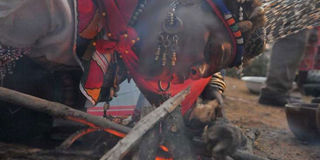Kenyans seek traditional healers for help with malaria, erectile dysfunction

A traditional healer gets the fire ready ahead of the traditional Cleansing and Thanksgiving ceremony at the historic Waaihoek Church in Bloemfontein on January 7, 2012. PHOTO | AFP
One in four Kenyans have sought help from a traditional healer at some point, with 31 per cent of poor Kenyans much more likely to have done so than the rich (17 per cent).
Most Kenyans have sought the services of traditional healers to treat malaria (18 per cent), erectile dysfunction (17 per cent), seduction (12 per cent) and work-related success (11 per cent), usually as an alternative of last resort after traditional medicine failed, states a recent research by education and health research firm Twaweza.
Thirty-six per cent of respondents linked traditional healers to witchcraft. Less than half of the respondents had not used a government health facility this year, possibly because of the prolonged doctors and nurses strikes for the better part of the year.
Far fewer Kenyans (47 per cent) used public health facilities in 2017 compared to 74 per cent the previous year. Use of private facilities rose from 16 per cent last year to 34 per cent this year.

A coconut juice trader under a tree with a signboard detailing services of a traditional healer in Malindi, Kenya. PHOTO | FILE | NATION MEDIA GROUP
NO FREE TREATMENT
Many respondents (44 per cent) cited lack of medical staff as the biggest challenge in the health sector. Although state policy directs that they should be getting treatment for free in public health centres, 29 per cent of pregnant women were asked to pay for care, as were 34 per cent of children under five diagnosed with malaria.
According to Twaweza Advocacy Manager Mr Brezhnev Otieno, the development either puts citizens’ health at risk or places a strain on their resources.
“Our findings present a powerful message to the government, which is the leading healthcare provider. Please take immediate action to restore faith in the public health system,” Mr Otieno said.
The research was conducted nationally as a mobile phone survey with 1705 respondents between July and August this year. The research is in sharp contrast with the government’s stated intention to improve universal healthcare access among Kenyans to 100 per cent by 2022.
Ministry of Health Cabinet Secretary Dr Cleopa Mailu said the government is committed to achieving universal healthcare targets as set out by the Constitution of Kenya 2010, Vision 2030, Kenya Health Policy and Kenya Health Sector Strategic Plan 2018-2022.
Speaking recently during a consultative meeting with development partners ahead of the Universal Health Care forum to be held in Tokyo, Japan this month, the Dr Mailu said the government was confident of achieving the target of 100 per cent universal health coverage for Kenyans within the next five years.
CUSHION FROM POVERTY
Dr Mailu said the state had introduced free maternity care in all public health facilities that has since seen the increase in skilled baby deliveries from 600,000 to 1.2 million per year, expanded health insurance through the National Health Insurance Fund (NHIF) and introduced health subsidies for the poor.
“We have eliminated the health service costs including all user fees for children under age five, thus significantly reducing the out-of-pocket healthcare burden currently estimated at 31 per cent of family expenditure due to the catastrophic costs incurred by using their own resources,” said Dr Mailu.
He added that the government is developing a health financing strategy togethre with development partners to achieve universal healthcare by further reducing the financial burden that comes with accessing healthcare.
“Our objective is to cushion people from poverty caused by out-of-pocket expenditure, spending colossal amounts of money to access health services,” he said.



